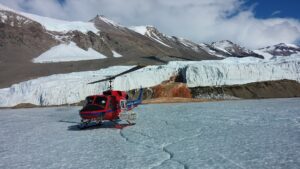The climate will kill us, and the mechanism will be greenhouse gas emissions, a new paper promises — albeit, 250 million years from now.
A study published Monday in the journal Nature Geoscience models an oncoming supercontinent that will prove unsurvivable. Pangea Ultima will cause “conditions rendering the Earth naturally inhospitable to mammals,” the University of Bristol team found.
Pangea Ultima’s formation would produce massive carbon dioxide, doubling the amount in today’s atmosphere. But that’s only one piece of the puzzle. The aging sun will also scorch the planet with 2.5% more wattage than today. And the vast inland areas would experience temperatures too extreme to tolerate.
What would this world look like? Basically, the continents would squish together, as seen on a conventional map. If you were anywhere around latitudes of about 30 degrees, you’d be having a very bad time. Average summer highs would reach a temperature represented by a color that does not exist on the scientists’ maps — which tops out at a burned meat-colored 60˚C.

Pre-industrial conditions on the left, post-industrial on the right. “g” represents the earth during warmer months, 250 million years from today.
When the age of mammals ends
Right now, the researchers call 66% of the planet “habitable.” By the year 250,002,023, that number narrows to 8%.
The event would bring a resilient lifeform to its knees. Mammals have inhabited “nearly every terrestrial biome” on earth during about 310 million years of existence, the paper points out. That’s about twice as long as dinosaurs, and we outlived their mass extinction and others. Heavy climatic fluctuations, like multiple ice ages, have also taken place during our tenure.
Interestingly, the researchers found this could be the only thing that mortally threatens mammals during the next several billion years. They even point out that no other factors will even injure the dominance of earth’s most prolific vertebrates.
Human-caused climate change does exist, they acknowledge. But “it is unknown whether or when [mammals] will ever reach a climatic tipping point whereby their ascendancy is threatened.”
At least not until a “runaway” greenhouse effect inevitably takes over in billions of years. In it, “all life will eventually perish.”
Before this physiological Armageddon, it does look like life on the blue planet will experience a pretty wide window of existence. What that might look like is anybody’s guess.
Lead author Alexander Farnsworth teased the possibility of our replacement, but didn’t hazard a guess at what might do it.
We are the dominant species but Earth and its climate decide how long that lasts,” Farnsworth told The Guardian. “What comes after is anyone’s guess. The dominant species could be something completely new.”






